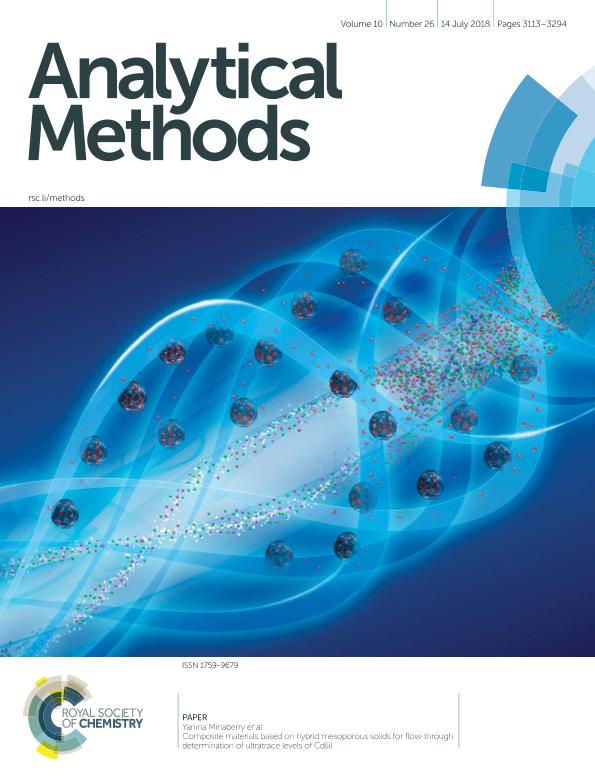Mostrar el registro sencillo del ítem
dc.contributor.author
Minaberry, Yanina Susana

dc.contributor.author
Stripeikis, Jorge Daniel

dc.contributor.author
Tudino, Mabel Beatriz

dc.date.available
2019-11-12T16:25:15Z
dc.date.issued
2018-07
dc.identifier.citation
Minaberry, Yanina Susana; Stripeikis, Jorge Daniel; Tudino, Mabel Beatriz; Composite materials based on hybrid mesoporous solids for flow-through determination of ultratrace levels of Cd(ii); Royal Society of Chemistry; Analytical Methods; 10; 26; 7-2018; 3144-3152
dc.identifier.issn
1759-9660
dc.identifier.uri
http://hdl.handle.net/11336/88634
dc.description.abstract
In this work we present a solid phase extraction (SPE) flow-through system coupled to graphite furnace atomic absorption spectrometry (GFAAS) for the determination of Cd(ii) at ultratrace levels. The flow system holds a minicolumn which was filled, one at a time, with three different lab-made materials: (a) mesoporous silica functionalized with 3-aminopropyl groups from 3-aminopropyl triethoxysilane (HMS); (b) HMS with a resin, Amberlite IR120; and (c) HMS-Amberlite IR120 and polyvinyl alcohol (PVA). All the solids were characterized by FTIR and SEM. Batch experiments were performed in order to study the optimum adsorption pH, the adsorption kinetics and the maximum adsorption capacity. The materials were compared in terms of their aptitude for the pre-concentration of the analyte under dynamic conditions. Microvolumes of HCl were employed for the release of cadmium and its introduction into the electrothermal atomizer. The operational variables of the flow system were also tested and optimized. A comparison of the figures of merit revealed that HMS-A-PVA was the best option from an analytical point of view: limit of detection = 4.7 ng L-1, limit of quantification = 16 ng L-1, RSD% = 4 (n = 6, 100 ng L-1), linear range: from LOQ up to 200 ng L-1 and a lifetime of over 600 cycles with no obstructions to the free movement of fluids, material bleeding or changes in the analytical sensitivity. The proposed method was shown to be tolerant to several ions typically present in natural waters and was successfully applied to the determination of traces of Cd(ii) in real samples. A full discussion of the main findings with emphasis on the metal ion/filling interaction is provided.
dc.format
application/pdf
dc.language.iso
eng
dc.publisher
Royal Society of Chemistry

dc.rights
info:eu-repo/semantics/openAccess
dc.rights.uri
https://creativecommons.org/licenses/by-nc-sa/2.5/ar/
dc.subject
CADMIUM
dc.subject
SOLID PHASE EXTRACTION
dc.subject
COMPOSITE MATERIALS
dc.subject.classification
Química Analítica

dc.subject.classification
Ciencias Químicas

dc.subject.classification
CIENCIAS NATURALES Y EXACTAS

dc.title
Composite materials based on hybrid mesoporous solids for flow-through determination of ultratrace levels of Cd(ii)
dc.type
info:eu-repo/semantics/article
dc.type
info:ar-repo/semantics/artículo
dc.type
info:eu-repo/semantics/publishedVersion
dc.date.updated
2019-10-16T15:21:59Z
dc.identifier.eissn
1759-9679
dc.journal.volume
10
dc.journal.number
26
dc.journal.pagination
3144-3152
dc.journal.pais
Reino Unido

dc.journal.ciudad
Cambridge
dc.description.fil
Fil: Minaberry, Yanina Susana. Universidad de Buenos Aires. Facultad de Ciencias Exactas y Naturales. Departamento de Química Inorgánica, Analítica y Química Física; Argentina. Consejo Nacional de Investigaciones Científicas y Técnicas. Oficina de Coordinación Administrativa Ciudad Universitaria. Instituto de Química, Física de los Materiales, Medioambiente y Energía. Universidad de Buenos Aires. Facultad de Ciencias Exactas y Naturales. Instituto de Química, Física de los Materiales, Medioambiente y Energía; Argentina
dc.description.fil
Fil: Stripeikis, Jorge Daniel. Instituto Tecnológico de Buenos Aires. Departamento de Ingeniería Química; Argentina
dc.description.fil
Fil: Tudino, Mabel Beatriz. Universidad de Buenos Aires. Facultad de Ciencias Exactas y Naturales. Departamento de Química Inorgánica, Analítica y Química Física; Argentina. Consejo Nacional de Investigaciones Científicas y Técnicas. Oficina de Coordinación Administrativa Ciudad Universitaria. Instituto de Química, Física de los Materiales, Medioambiente y Energía. Universidad de Buenos Aires. Facultad de Ciencias Exactas y Naturales. Instituto de Química, Física de los Materiales, Medioambiente y Energía; Argentina
dc.journal.title
Analytical Methods
dc.relation.alternativeid
info:eu-repo/semantics/altIdentifier/url/http://pubs.rsc.org/en/Content/ArticleLanding/2018/AY/C8AY00879E
dc.relation.alternativeid
info:eu-repo/semantics/altIdentifier/doi/http://dx.doi.org/10.1039/C8AY00879E
Archivos asociados
